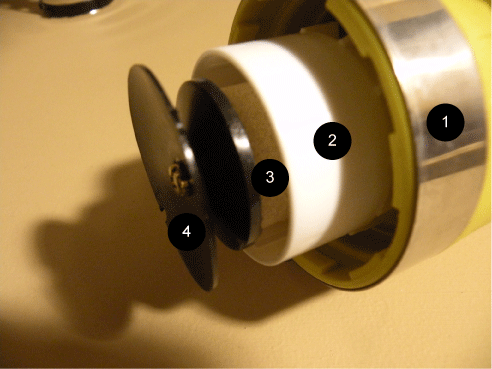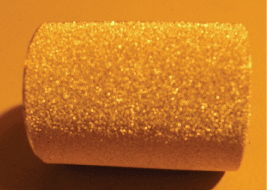This page provides more information about the compressed air filter element is part of a series of pages on this site that discuss the compressed filter, what they are, what they do, and where you use them.
If you wish to read the pages from start to finish, page one of the compressor air filter is here.
One of the innards of a compressed air filter is the filter element, shown below, item 3. We have discussed items 1 & 2 on an earlier page.

Air Filter Element
Item 3 in the image above is the air filter element.
We have removed this element from the air filter, and shown it below. Depending on the type of compressed air filter you have, your compressed air filter element may be similar in appearance to this one. Yours might also be a different color, it might be made of sintered plastic beads instead of the sintered brass element that is shown in this photo, or it may be made up of other materials entirely.
Regardless, they all do the same thing to the compressed air stream.

What’s sintered? It’s a way of making an object out of thousands of small beads of material that fill a mold and then are heated to the point where the beads just start to melt. Then the part is cooled, the slightly melted beads have bonded together, and the result is an object that is light, and for filter element purposes, is full of small and intricate air passages for the compressed air to flow through.
In a compressed air filter element the flow of air moves through these thousands of tiny air passages in the element, and in the process, the air is stripped of any debris that is larger than the air passage, may lose more water, and the rapid twisting and turning of the compressed air through the element may actually convert some of the water vapor in the air into free water, which is then stripped from the air stream as it passes through the element.
Air filter elements do get plugged
One of the maintenance issues to do with a compressed air filter is to check periodically for the condition of this element. Since it’s purpose is to remove dust and debris from the air stream, the air passages and the surface of the element become blocked over time.
The symptom is a significant pressure drop in the air supply to the air tool.
A quick check if you have this symptom is to shut off the air supply to the filter, very carefully open it, remove the innards completely, reattache the polycarbonate bowl and the bowl guard, and recharge the air system. Do you have good flow to our air tool again? Then it’s time to replace the filter element.
Another diagnostic method is to install a pressure gauge upstream from the compressed air filter, and another just downstream from it. Since the air filter is an impediment in the line, there will be a pressure drop across the filter, and this will be shown on the two gauges. Air needs to be moving through the system for the difference to display. A pressure drop of 4-6 PSI is normal. If the pressure drop is exceeding 10 PSI, and you have a typical general purpose element in the filter, odds are good that the element is plugging up.
Air filter element sizing
When we talk about sizing, we are not talking about the physical size of the air filter element. We are talking about the sizing of the holes in the element.
These hole sizes are typically measured in microns. The micron is also known as the micrometre.
Wikipedia provides the definition. “The micrometre (International spelling as used by the International Bureau of Weights and Measures; SI symbol: µm) or micrometer (American spelling) is an SI derived unit of length equaling 1×10−6 of a metre (SI standard prefix “micro-” = 10−6); that is, one millionth of a metre (or one thousandth of a millimetre, 0.001 mm, or about 0.000039 inch).”
Regardless of whether it is a micron or a micrometre, one of them is very small. There are about 1200 microns of space in the eye of a needle! Tobacco smoke has particles 0.01 to 1 microns in size. (Reference: www.peakpureair.com)
The element shown has a 20 micron element. That means that any debris in the air stream larger than 20 microns in size will be trapped by this element.
An air filter element with a micron rating upwards of 10 microns to about 50 microns (it varies by the manufacturer) is considered a general purpose element and will likely be the size of the element in your air filter.
Air filter elements with passages smaller than 5 microns are considered more specialty filter elements, and are used for specific purposes.
Two things about that.
One is that if you add an air filter to your air stream with an element size smaller than 5 microns, you will ALWAYS want to add another filter with a general purpose sized element upstream from it, and for the typical DIY home compressor user, the general purpose element in an air fitlter will be all you need unless you have a specific issue in air quality to deal with.
Now we are going to discuss item 4 in the image at the top of this page, and that information is right here.
